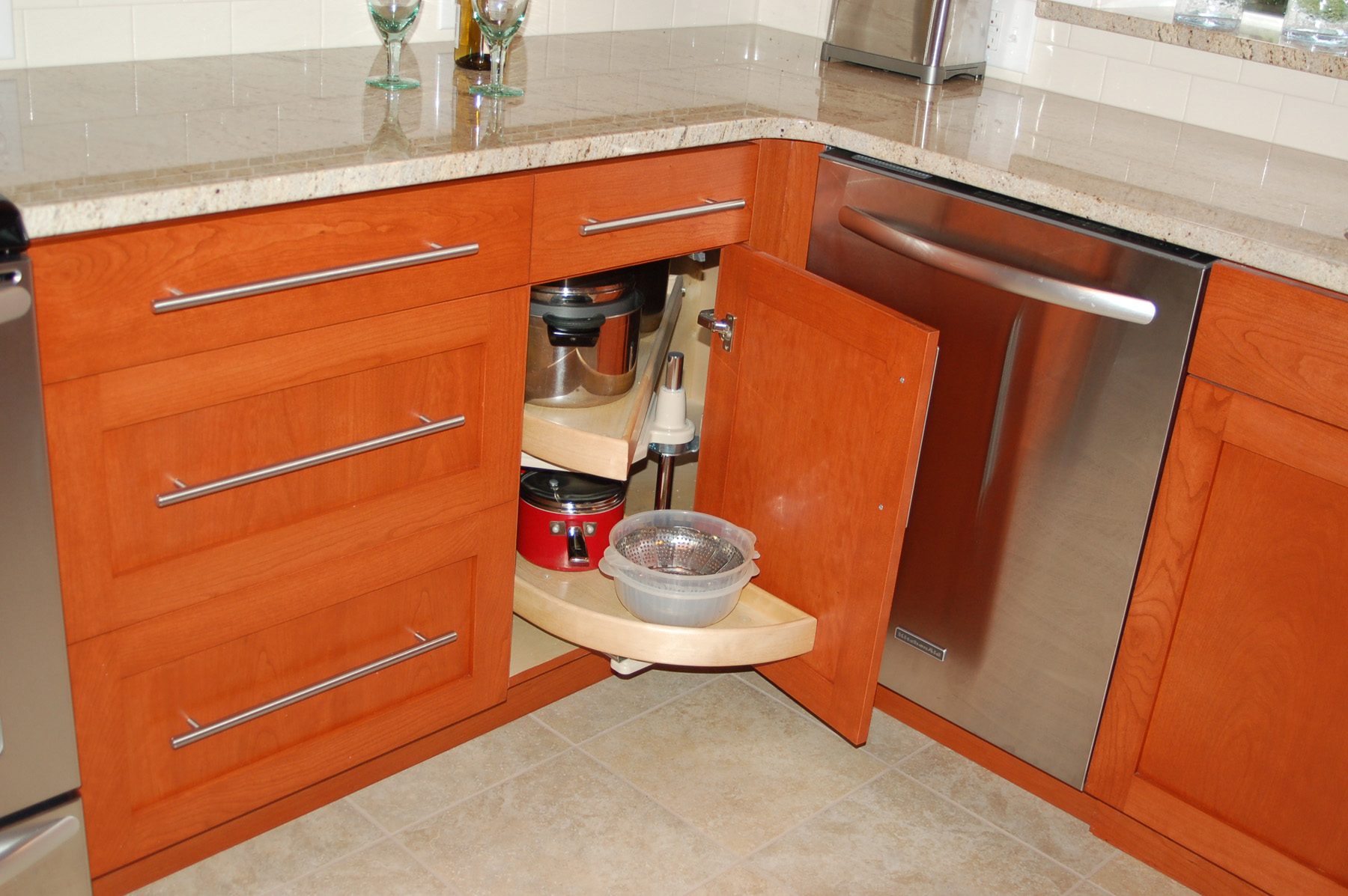Installation and Usage

Corner lazy Susan cabinets offer significant storage advantages, but their installation and organization require careful planning. This section details the installation process and provides strategies for maximizing space utilization.
Corner Lazy Susan Cabinet Installation
Proper installation ensures smooth operation and longevity. Always prioritize safety by following these steps:
- Preparation: Gather necessary tools: measuring tape, level, screwdriver (Phillips and flathead), drill, safety glasses, and possibly a stud finder. Ensure the cabinet’s dimensions align with the allocated space. Turn off the power to any nearby electrical outlets.
- Cabinet Placement: Carefully position the cabinet in the designated corner, ensuring it’s level and plumb. Use shims to adjust for uneven floors if necessary. Mark the locations for mounting screws.
- Mounting: Drill pilot holes at the marked locations, then secure the cabinet to the wall studs using appropriate screws. Check for stability and levelness.
- Lazy Susan Installation: Follow the manufacturer’s instructions for installing the lazy Susan mechanism. This usually involves attaching the rotating trays to the base and ensuring they spin smoothly.
- Final Checks: After installation, thoroughly inspect the cabinet for stability and functionality. Test the lazy Susan’s rotation and ensure it operates smoothly. Replace any electrical outlets if necessary.
Optimal Organization Techniques
Efficient organization maximizes storage space and accessibility. The following table provides suggestions for item placement within a corner lazy Susan cabinet:
| Item Types | Storage Location Suggestions | Space Maximizing Tips | Example |
|---|---|---|---|
| Frequently Used Spices | Innermost rotating tray | Use small, stackable containers | Small spice jars in a tiered organizer |
| Canned Goods | Outer rotating tray | Arrange cans vertically to save space | Canned tomatoes and soups placed upright |
| Baking Supplies | Fixed shelves (if applicable) | Utilize space-saving containers and dividers | Flour, sugar, and baking powder in airtight containers |
| Large Serving Dishes | Bottom shelf or back of the cabinet (depending on design) | Stack similar items together | Large platters and bowls stacked carefully |
Visual Representation of a Well-Organized Corner Lazy Susan Cabinet
Imagine a corner cabinet with two rotating trays. The innermost tray holds frequently used spices in small, uniformly sized containers, arranged for easy visibility. A small tiered organizer helps to maximize vertical space. The outermost tray houses canned goods, neatly arranged vertically to optimize space. If the cabinet features additional fixed shelves, the upper shelf might contain baking supplies in airtight containers and dividers, while the lower shelf or the back of the cabinet holds larger serving dishes stacked carefully. This arrangement ensures that frequently accessed items are easily within reach, while less frequently used items are still readily accessible but don’t obstruct the workflow. The entire system is designed for seamless rotation, allowing for easy access to all stored items.
Considerations for Purchase and Maintenance: Best Lazy Susan Corner Cabinet

Selecting and maintaining a corner lazy susan cabinet requires careful consideration of several factors to ensure optimal functionality and longevity. The right choice depends heavily on your kitchen’s layout, storage needs, and personal preferences. Proper maintenance, in turn, will significantly extend the life of your cabinet and preserve its aesthetic appeal.
Choosing the Right Size and Style
Determining the appropriate size and style of your corner lazy susan cabinet involves a careful assessment of your kitchen’s dimensions and your storage requirements. Measure the available corner space precisely to ensure a proper fit. Consider the depth of the cabinet; a deeper cabinet will offer more storage but may protrude further into the kitchen. The style should complement your existing kitchen cabinetry. For instance, a modern kitchen might benefit from a sleek, minimalist lazy susan, while a traditional kitchen might suit a more ornate design. Think about the type of lazy susan mechanism; some offer single-tiered rotation, while others provide double- or even triple-tiered options for maximized storage. Finally, assess the materials available; wood, metal, and composite materials each offer unique aesthetic and durability characteristics.
Maintenance Procedures for Different Materials
Regular maintenance is crucial for preserving the appearance and functionality of your corner lazy susan cabinet. The specific cleaning and preventative care will depend on the material. Wood cabinets require gentle cleaning with a damp cloth and a mild wood cleaner; avoid harsh chemicals or abrasive cleaners that could damage the finish. Regular polishing with a suitable wood polish will enhance the wood’s natural beauty and protect it from moisture damage. Metal cabinets, typically stainless steel or aluminum, are generally more durable and easier to clean. A simple wipe down with a damp cloth and a mild detergent is usually sufficient. For stubborn stains, a non-abrasive cleaner can be used. Composite materials, such as melamine or laminate, are also relatively low-maintenance and can be cleaned with a damp cloth and a mild detergent. Avoid excessive moisture, as it can damage the laminate finish. For all materials, preventative measures like promptly wiping up spills and avoiding placing excessively hot items directly on the cabinet surfaces will contribute to its longevity.
Addressing Common Issues and Troubleshooting, Best lazy susan corner cabinet
Addressing potential problems proactively can prevent minor issues from escalating into costly repairs. For instance, if you notice any squeaking or sticking in the lazy susan mechanism, lubricating the moving parts with a silicone-based lubricant can often resolve the problem. Loose hinges can be tightened with a screwdriver. If the cabinet doors are misaligned, adjusting the hinges can restore their proper alignment. Addressing these minor issues promptly can prevent more significant problems down the line and ensure the continued smooth operation of your corner lazy susan cabinet. Regular inspection, including checking for loose screws, damaged components, and signs of wear, is essential for early detection and prompt remediation of potential issues.
